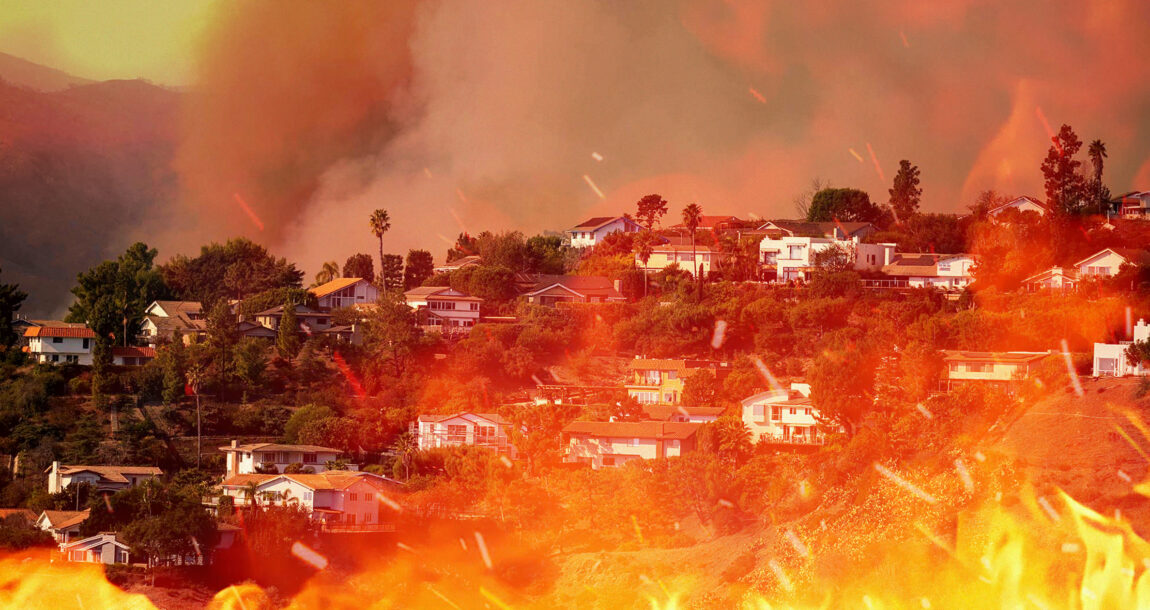From wildfire to conflagration: What sets the LA blazes apart?

Wildfires destroy thousands of acres in the U.S. every year. But what made the California wildfires so intense and destructive, burning nearly 50,000 acres and destroying more than 12,000 homes? A panel of CoreLogic experts looked at the factors that moved the Los Angeles event from a wildfire to a conflagration.
The combination of dry conditions, heat and extreme winds led to an extreme event, said Tom Jeffrey, geospatial scientist at CoreLogic. Those factors included:
- Dry conditions. Los Angeles is experiencing a drought, along with low relative humidity and hot air temperatures. The drought conditions dried out vegetation, turning it into fuel for wildfire.
- Hot, dry Santa Ana winds that typically strike Los Angeles between October and April had sustained speeds of 30-50 mph and gusts of up to 100 mph, the strongest measured in the past 10 years. “These are extreme factors. They are not the normal factors we associate with wildfire activity,” Jeffrey said.
Los Angeles received 0.16 inches of rain over the past eight months, he said. “Southern California tends to get a lot of precipitation during this time of the year. Remove the precipitation and now all you have are wind and dry fuels.”
In addition, Southern California had record rainfall about two years ago, spurring the growth of vegetation such as grasses and light brush. With dry conditions now prevailing, that new vegetation has dried out and become what Jeffrey called “flash fuels.”
The National Weather Service defines “extremely critical” fire weather as having
- Sustained winds of 30 mph or more.
- Relative humidity of less than 10%.
- Drought conditions.
- Temperatures above 70 degrees.
“In the U.S., we’ve never met all four of those factors before,” Jeffrey said.
A wildfire begins when vegetation catches fire, he said. Dry fuels and strong winds create a fast-moving fire. Homes scattered among the vegetation were the first to ignite. Homes along the edge of dense urban development that bordered the vegetation were next. From there, the fire transitioned from a wildfire to a conflagration. At that point, the structures became the primary fuel that fed the fire. Wind-borne embers moved the fire away from its original point and simultaneous structure fires increased the intensity.
The number and location of simultaneous fires, along with the extreme wind speeds, made it difficult for crews to stay ahead of the fire.
Loss potential
About 90% of the homes affected by the Palisades and Eaton fires were destroyed, said Tom Larson, CoreLogic senior director of insurance solutions. More than 19,000 homes were affected, more than 13,000 were likely damaged and more than 12,500 sustained significant damage. The insured loss from those two fires is estimated at between $35 billion and $45 billion.
Factors that are driving up those estimated insured losses, he said, include the age of the houses (between one-third and one-half of the homes affected were built before 1960) and the larger than average size of the homes.
Larson noted that homes that survived the wildfires are at risk of mudslides over the next one to two years because of ground instability and lack of vegetation holding soil back.
From wildfire to conflagration
Wildfires are a naturally occurring phenomenon and they aren’t going away, said Jamie Knippen, senior product manager with CoreLogic. But four factors turned the Los Angeles wildfires into a conflagration, she said. Those factors are:
- Building density.
- Structure characteristics.
- Large flying embers.
- Weather and climate characteristics.
© Entire contents copyright 2025 by InsuranceNewsNet.com Inc. All rights reserved. No part of this article may be reprinted without the expressed written consent from InsuranceNewsNet.com.
Susan Rupe is managing editor for InsuranceNewsNet. She formerly served as communications director for an insurance agents' association and was an award-winning newspaper reporter and editor. Contact her at [email protected].






How to get people to share personal information
Mercury Insurance has paid out $80M to wildfire victims, has ‘sufficient liquidity’
Advisor News
- Flexibility is the future of employee financial wellness benefits
- Bill aims to boost access to work retirement plans for millions of Americans
- A new era of advisor support for caregiving
- Millennial Dilemma: Home ownership or retirement security?
- How OBBBA is a once-in-a-career window
More Advisor NewsAnnuity News
- 2025 Top 5 Annuity Stories: Lawsuits, layoffs and Brighthouse sale rumors
- An Application for the Trademark “DYNAMIC RETIREMENT MANAGER” Has Been Filed by Great-West Life & Annuity Insurance Company: Great-West Life & Annuity Insurance Company
- Product understanding will drive the future of insurance
- Prudential launches FlexGuard 2.0 RILA
- Lincoln Financial Introduces First Capital Group ETF Strategy for Fixed Indexed Annuities
More Annuity NewsHealth/Employee Benefits News
Life Insurance News
- Private placement securities continue to be attractive to insurers
- Inszone Insurance Services Expands Benefits Department in Michigan with Acquisition of Voyage Benefits, LLC
- Affordability pressures are reshaping pricing, products and strategy for 2026
- How the life insurance industry can reach the social media generations
- Judge rules against loosening receivership over Greg Lindberg finances
More Life Insurance News